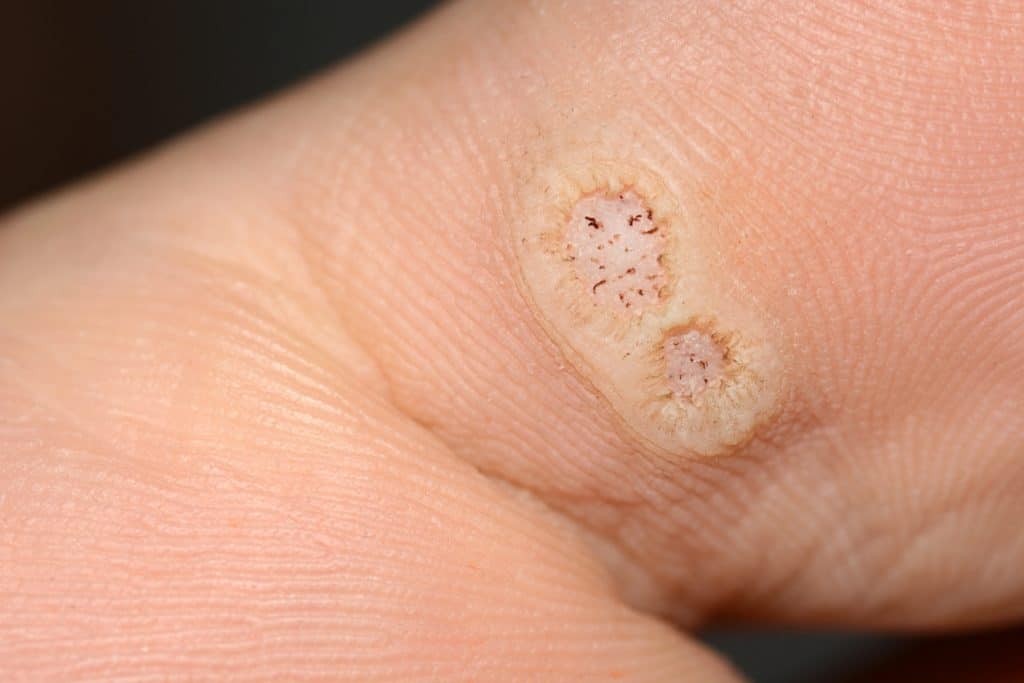How To Get Rid of Plantar Warts
A plantar wart is a bumpy growth on the skin that is caused by a viral infection. Plantar warts can be found anywhere on the foot, but are usually on the bottom. They are most common in children, adolescents, and the elderly, though anyone can get a plantar wart. These growths may last for months or years but often clear on their own. If they become painful or you’d like to clear them up more quickly, treatment is available.
Plantar Wart Causes

Plantar warts are caused by a common virus called the human papillomavirus, or HPV. Over 100 strains of this virus exist, and a few of these strains cause plantar warts, whereas others cause warts on different areas of the body. Everyone’s response to contact with the virus is different, even within the same family, and some will develop warts, whereas others will not.
The virus that causes plantar warts thrives in warm, moist places. These might include a locker room, public shower, swimming pool, or yoga or martial arts studio. It doesn’t typically spread from direct person-to-person contact, but as one walks barefoot in these locations, the virus can enter the body through imperceptible cuts, breaks, or weak spots on the sole of the foot.
Who Gets Plantar Warts?
Those most likely to develop plantar warts include:
- Children, adolescents, and the elderly,
- People with weakened immune systems,
- Those who’ve had plantar warts previously, and
- Barefoot people walking in common areas that are warm and wet.
Identifying Plantar Warts

Plantar warts typically develop at the base of the toes or the ball or heel of the foot. They appear as rough, bumpy growths and can be similar in color to your skin or lighter in color on those with darker skin. They may look tough and thick like a callous or simply appear as a bump that interrupts your foot or toe’s ridges and lines. A plantar wart may have tiny black dots on its surface. These are clotted blood vessels called wart seeds.
Plantar warts can be singular or appear in clusters. Singular warts are referred to as solitary warts. Over time, they may grow in size or multiply to form other solitary warts. Plantar warts that appear in clusters are called mosaic warts. They are more challenging to treat than solitary warts.
When to See Your Foot Specialist
Plantar warts are generally harmless. Depending on the size and location of the wart, however, it can cause pain when standing or during activity. If your wart interrupts your daily activities, it’s a good idea to seek treatment. It’s also particularly important to see your foot specialist if you have diabetes, a weakened immune system, or poor sensation in your feet.
See your foot specialist If the wart continues to grow, changes shape, or bleeds. See your specialist for additional treatment and testing if you’ve had a plantar wart treated, but it returns. Also, see your doctor if you aren’t sure whether the growth is a wart.
Plantar Wart Prevention
To help prevent infection by the virus that causes plantar warts:
- Keep your feet clean and dry,
- Wear slippers or sandals around pools, locker rooms, or public showers,
- Don’t pick at or scratch warts, and
- Wash your hands thoroughly if you come in contact with a wart, even your own.
Plantar Wart Home Treatments

If a plantar wart causes you pain while walking or wearing shoes, a moleskin patch can help relieve the offending pressure. Wear comfortable shoes and socks, and avoid anything that increases pressure on the tender area.
Your podiatrist may recommend a home salicylic acid treatment, though these generally take two to three months to work. If your doctor does prescribe an over-the-counter medication, be sure to follow their instructions exactly. Plantar warts can be stubborn, so consistent treatment is imperative.
While most plantar warts clear on their own over time, especially in younger children, many people prefer the faster route of having them professionally removed.
Call your orthopedic specialist immediately if you have any signs of infection, including pus draining from the wart, red streaks or swelling around the wart, or a fever.
Podiatric Plantar Wart Treatments
Cutting or removing a plantar wart yourself may do more harm than good. Your podiatrist or orthopedic foot specialist will determine the best treatment options. They may use topical or oral medications, freezing, laser therapy, injection treatment, or surgery to remove your wart.
They will decide if a biopsy or additional testing is necessary and give you home-care and follow-up instructions.
If you have questions about your feet and would like to talk to a podiatrist, please feel free to contact us. Dr. Jason Dickson, our podiatrist, can answer any questions you may have.
Leave a Reply